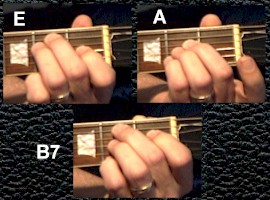Scroll through the lesson and click on notation/video/audio links to load the interactive players.
Please subscribe to get full access to all lessons for only $7.95/month PLUS 1 week free trial.

Riff Interactive lessons are
LESS expensive and
MORE interactive than alternatives!
More Info
|
|

Country Guitar For
Beginners
Lesson 3
Lyle: This lesson is very much like the other two
lesson so far. It has three chords in the progression using the very basic 1 - 4
- 5 chord progression formula. This lesson is in the key of E so the three
chords will be E, A, and B7:
chords

Lyle:
The chord progression is real short (8 bars) and simple this time:
II:E I IA
I IB7 I IE
I :II
Lyle:
Here's the looping jam track for this lesson:
Lyle:
The rhythm guitar part is very important to set up the sound of the country
style. Just like the last two lessons, you'll use an alternating bass line and a
little bit of "walking bass". Here's how the whole rhythm guitar pattern is
played:
Lyle:
The lesson riffs are played with a pick, but you can use your fingers too.
Earlier today I was strumming the rhythm part with my fingers. Try using your
thumb for the bass notes. Then brush or strum the rest of the strings with the
backside of your fingers. Strum down whether you're using a pick or not. Here's
a video clip of this:
Leadplayer:
Nice and easy start to my first country session!
Lyle: My favorite part of this rhythm riff is the
last two notes.
Lyle: Try playing along with me using the looping
jam track once you have learned the chord changes, the alternating bass notes
and the little walking bass lines. Remember, the rhythm guitar parts are the
most important part of playing songs in any style. Get them down strong so you
can play them consistently with the jam tracks.
Lyle:
Playing lead guitar is what seems to impress everyone so let's learn some riffs!
Since you're using the three chords in E, you want to be familiar with the major
pentatonic scales for each chord in the progression.
Lyle:
Just like in the last two lessons I taught you to follow each chord with it's
own major pentatonic scale. If you learn these patterns now, you'll be able to
learn the first solo much easier and faster:
Lyle:
Use your 1st and 3rd fingers for these scale patterns. Whatever is most
comfortable for you.
Lyle: The Major Pentatonic scale is made from the
1, 2, 3, 5, and 6 tones of the major
scale.
Lyle: Now try this solo which is made from those
scales. You can loop the tab and even slow it down if you want.
Lyle:
You can play this solo on acoustic or electric. If you're using an electric
guitar I suggest using the bridge pickup and a fairly clean tone. Pick the
strings closer to the bridge than you normally would to get a little extra
"twang". Learn this little riff next:
Lyle: I
used this riff in the lesson sample to make a complete solo! Watch this video of
me using this riff over and over through the whole progression:
Lyle:
Since you're jamming in the key of E major, the notes from the E major scale are
very important to know when making up riffs for a jam like this. Look at how the
notes from the E major scale lay out on the fretboard:
Lyle: By
taking those notes on the first and second strings, you can make a long flowing
riff. Here's an example:
Lyle:
What you're doing here with the long descending riff is playing two notes
together in harmony. They are called "thirds". Notice I add a little bit of riff
2 near the end of solo 3.
Lyle: The next solo is a variation of solo 3.
It's not really for beginners because it's fast, but I thought I'd show it to
you anyway. It has the same descending riff, just played a lot faster!
gord: Solo 3 is
only roots and 3rds?
Lyle: Yes, some are major thirds, some are minor
thirds.
Lyle:
Remember you can loop and slow down the tab to make it easier to learn and to
play along with.
Lyle: I just threw in that solo 4 in as an
example of something you could work up to if you wanted.
Lyle: Here's some other riffs I put together
using the major pentatonic positions.
Lyle: Bend just the 3rd string up a whole
step.
Lyle: The next riff is a little different. You
play a riff pattern the same way for each chord:
Lyle: I
like this next riff. Again it uses the major pentatonic shapes you used earlier
but this time up an octave on the neck:
Lyle:
This riff is in E, but you could learn it and move it to any other
key:
Lyle:
That about it for this lesson.
Lyle: You should at least learn rhythm part
perfectly. Then learn the scales and solo 1 as best you can. all the other stuff
is extra credit stuff!
|
<< load notation from left
|
|
<< load audio from left
|
<< load audio from left
|